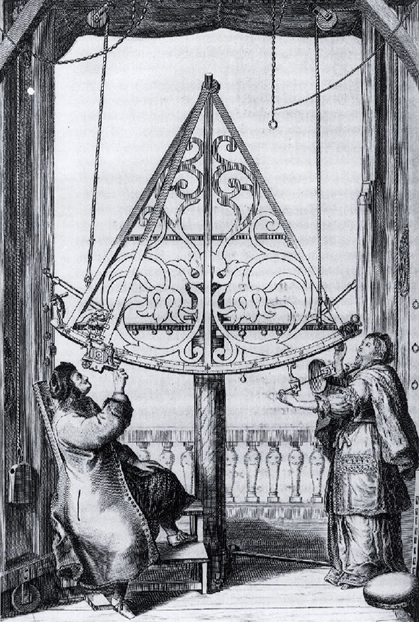1757
Celestial Navigation
Tycho Brahe (1546–1601), Isaac Newton (1643–1727), John Bird (1709–1776)
Prior to the invention of the first astronomical telescopes, ancient through medieval astronomers had to use naked-eye instruments such as armillary spheres, celestial globes, and astrolabes to establish the altitude and azimuth of celestial bodies (what astronomers call their declination and right ascension, respectively), as well as the relative distances between objects in the sky. The desire for higher-precision measurements meant that circular instruments like the astrolabe would have to be built in very large and cumbersome sizes. Astronomers and instrument makers thus began using only semicircular segments to decrease instrument size while maintaining precision.
Measuring instruments made from a quarter of a circle—quadrants—began appearing in the mid-sixteenth century. Tycho Brahe invented a large pedestal-mounted or framed version spanning one-sixth of a circle and called it a sextant. These devices continued to provide unsurpassed positional measurement accuracy even after the invention and proliferation of the telescope. One-eighth circle versions—octants—appeared in the eighteenth century.
Framed quadrants, sextants, and octants were fine instruments on land, but they were impractical at sea, where more precision was needed. Miniaturization, flexibility, and simplicity of operation on a moving platform were required. Isaac Newton had proposed a modification to the quadrant using two mirrors (like his reflecting telescope design), and in 1757 a portable version of the sextant was built by the English instrument maker John Bird that incorporated Newton’s double-mirror design. Many modern sextants essentially mimic this eighteenth-century design, with the addition of higher-powered optics and the incorporation of composite materials. Even in our computerized and global-positioning-system era, it is heartening that many mariners today are still required to know how to perform the basics of celestial navigation using a sextant.

A portable sextant from around 1890 used by the US Coast and Geodetic Survey and based on the original sextant design by John Bird.
SEE ALSO Astronomy in China (c. 2100 BCE), Western Astrology (c. 400 BCE), Large Medieval Observatories (1260), Brahe’s “Nova Stella” (1572), First Astronomical Telescopes (1608).
Polish astronomer Johannes Hevelius and his wife, Elisabeth, using an astronomical sextant in 1673.
